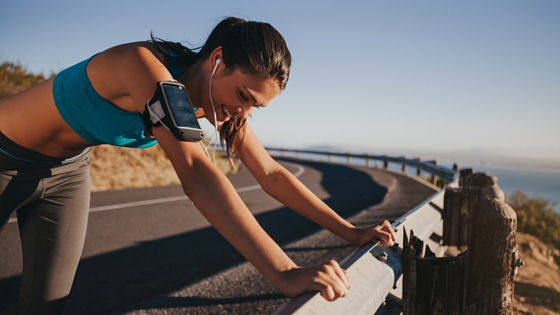alleviating tight muscles with methods outside of stretching
By Will Bennett
To reach your full potential as a runner, it is necessary to do more than “just run.” Yes, running is an essential part of the equation, but at some point or another, even the fastest Ferrari has to be serviced. This is why I am going to show you four strategies that you can implement right now to help your body stay in prime shape for running.
But first, I want to briefly mention why you will want to include these movements into your fitness repertoire.
If you have ever suffered from shin splints, achy achilles’ tendon, calf tightness, or other pain or tightness in the lower extremities, you’re not alone. Every runner has at least some fault in their running form; no one is perfect. However, what separates the extraordinary from the ordinary, are the individuals who are willing to do that little bit extra.
Certain mobility or soft tissue modalities can help minimize damage done while running and correct some simple gait issues spawned from compensatory patterns. In simpler terms, if pain or tightness is causing you to change how you naturally run, these exercises may help alleviate your issue.
Alleviating Pain and Tightness
Soft Tissue – alleviating Tight calves
If you experience tightness in your calves while running, walking, or just doing day to day activities, then using a foam roller or tiger tail can be a great modality to help improve that area. During running, the calves and achilles tendon work together to absorb the force of each step and apply that force to the ground to cause propulsion.
This action done repeatedly can cause pain or tightness in the area due to a multitude of reasons like overtraining, not warming up properly, not getting adequate rest, etc. Applying these rolling techniques before and after exercise can help you improve the quality of tissue and avoid pain and tightness.
Lacrosse ball – alleviates foot pain
A personal favorite of mine, this modality can be very useful for restoring the pliability of fascia (system of connective tissue that runs throughout whole body). When we wear shoes, our body depends on the cushion of the shoe to absorb the forces of running. As this happens, the muscles in our feet and surrounding area can become weakened and dysfunctional. Rolling the bottom of your foot with a lacrosse ball can help restore function and to those tissues.
Improving ankle mobility
Many people often overlook ankle mobility when searching for the culprit responsible for their pain or immobility. Ankle dorsiflexion is important because without it, the body will compensate somewhere else to get the desired range of motion. People who struggle with “sitting back” or keeping an upright torso during a squat often have poor dorsiflexion through their ankles.
The knee should be able to comfortably track over the toe without the heel lifting off the ground. If you struggle with this motion, this exercise can restore some essential range of motion
Barefoot walks
https://youtu.be/__dSVSKD3Eg
At this point, we are aware running puts a lot of stress on the lower extremities. Different muscle groups are used at different stages of running, so it is important that we work through a variety of strengthening exercises to target all muscle groups. Varying barefoot walks are a great strategy to counteract the effects caused by running with thick cushioned shoes. Keeping the muscles of the feet conditioned can help alleviate pain caused from an altered gait caused by running shoes.
Recap
Putting a lacrosse ball or other type of round object under your foot may seem silly, but this exercise has personally worked for me very well. I enjoy exercising barefoot and often incorporate high impact movements like skips and bounds into my workouts. After a short stint of not completing any high impact movements due to a sprained ankle, I noticed some pain in the bottom of my foot resulting from tightness in my arch.
I had always considered my tissue to be fairly supple, but it seemed that the tissue had become deconditioned due to inactivity. After noticing the pain, I used a lacrosse ball and followed the strategies similar to the ones displayed in video #2. After a week of doing the soft tissue work at the beginning and end of each workout, the pain was gone.
Tissue quality is important, and if we do not perform the necessary work to keep our tissue supple, then we lose function and end up with pain and tightness. I hope you will find the same success in these exercises as I have. Feel free to email me with any questions, or share an experience where you saw improvement resulting from soft tissue work!
Run, Move and Feel Better
Being able to put all of this information together for your own specific needs can be overwhelming and difficult. Many of my clients have previously faced problems with recurring injuries that have forced them to take time off from running. However, with an individualized approach and some dedication, many clients are often able to overcome what they thought were chronic injuries.
If you are currently experiencing pain from running or have any issues in another area of fitness, I would love to help. Please feel free to email me at Will@wilmingtonperformancelab.com with any questions you may have.
Get Your Free Assessment
I am a personal trainer because I believe everyone should be their best self. Every individual has the ability to achieve this, but many need someone who can unlock their potential. I take pride in my ability to help clients push themselves to places they have never been before and achieve their every goal. Running a 5k, losing 10 lbs, completing a marathon or Spartan Beast, no matter the challenge, every individual possesses the inner strength to complete their goal.
“To give anything less than your best is to sacrifice the gift.” -Steve Prefontaine


